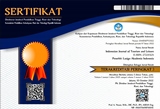Slum Tourism: Representing and Interpreting Reality in City
Abstract
Slum areas are often seen in urban spatial policy gaps. The slum area becomes a dilemma, it portrays the unsuccessful management of a city area, on the other hand the reality of the city has the potential to become slum area tourism as an alternative attraction for tourism in urban areas. Efforts made by stakeholders in terms of city management tend to ignore slum areas as a city reality that has never touched a solution to the problem. Slum areas with social problems require real solutions. Through tourism in slum areas, residents innovate to represent and interpret their territory to find solutions for themselves. So far, studies on slum area tourism regarding how local residents represent and interpret their territory are still rare. Therefore, this study tries to look at the initiative to practice representation and interpretation of local residents in their area, and how stakeholders represent slum areas in their area through a qualitative study using a city tourism approach. Based on the results of data collection, a description of the situation of slum areas and their communities can practically represent themselve as the reality of the city and present themselve as part of the development of city tourism. By imaging the slum area, local people earn income from interacting with tourists who hope to get a complete experience of the city's tourist destinations they visit. On the other hand, local communities who are involved in the practice of representing slum area tourism indirectly criticize city management by displaying the contrast between slum area residents and tourists through digital media within the framework of local initiatives as a form of development participation.
Keywords
Full Text:
PDFReferences
Acioly, J. C. (2010). The Informal City and the Phenomenon of Slums : the challenges of slum upgrading and slum prevention. New Towns for the 21st Century; the Planned vs. the Unplanned City INTI Conference, June 2009, 222–231.
Bolay, J.-C. (2006). Slums and Urban Development: Questions on Society and Globalisation. European Journal of Development Research, 18(2), 284–298. https://doi.org/10.1080/09578810600709492
Booyens, I., & Rogerson, C. M. (2019). Re-creating slum tourism: Perspectives from South Africa. Urbani Izziv, 30, 52–63. https://doi.org/10.5379/urbani-izziv-en-2019-30-supplement-004
BPS. (2021). Penduduk Miskin di DKI Jakarta Tahun 2020 - Unit Pengelola Statistik.
BPS DKI. (2022). Statistik Sektoral Provinsi DKI Jakarta. Unit Pengelola Statistik.
Brown, T. (2008). Design Thinking. https://doi.org/10.1145/3347709.3347775
Butcher, J. (2005). The moralisation of tourism, and the ethical alternatives. In Tourism Business Frontiers: Consumers, Products and Industry. https://doi.org/10.4324/9780080455914
Creswell, J. W. (2009). Research Design; Qualitative, Quantitative and Mixed Methods Approaches (Third Edit). Sage Publications. https://doi.org/10.1007/s13398-014-0173-7.2
Darmawan, F., & Nurhalin, R. (2016). Pengelolaan Wisata Kumuh Kampung Luar Batang Slum Tourism Management di Kampung Luar Batang. In ui.ac.id (Vol. 4, Issue 1).
Frenzel, F. (ed). (2012). Slum Tourism Poverty, power and ethics (F. (ed) Frenzel (ed.)).
Hasanawi, A. et al. (2019). Improvement of Community Governance to Support Slum Upgrading in Indonesia. The Indonesian Journal of Development Planning, 3(3), 347–358. https://doi.org/10.36574/jpp.v3i3.88
Holst, T. (2015). Touring the Demolished Slum? Slum Tourism in the Face of Delhi’s Gentrification. Tourism Review International, 18(4), 283–294. https://doi.org/10.3727/154427215x14230549904134
Hutnyk, J. (1997). The rumour of Calcutta: tourism, charity and the poverty of representation. In Choice Reviews Online (Vol. 34, Issue 09). ZED BOOKs. https://doi.org/10.5860/choice.34-5167
IDEO.org. (2015). The Field Guide to Human-Centered Design.
LSE. (n.d.). The creative ‘slum.’
Ma, B. (2010). A Trip into the Controversy: A Study of Slum Tourism Travel Motivations. Penn Humanities Forum on Connections, 1–50.
Mahayni, A. R., & Medlej, H. (2018). Slum Tourism: A Necessity. May.
Matias, E., & Rahu, S. (2014). The Slum Outside: Elusive Dharavi. Strelka Press.
Munggaran, R. A., Setiono, L. S., Sosiologi, D., & Indonesia, U. (2020). i Orientasi Slum Tourism Jakarta Hidden Tour sebagai Praktik Kosmopolitanisme. Sosietas Jurnal Pendidikan Sosiologi, 10(2), 841–850.
Prayitno, B. (2016). Skema Inovatif Penanganan Permukiman Kumuh (2nd ed.). Gadjah Mada University Press.
Ratho, A. (2019). Slum Tourism: Promoting Participatory Development or Abusing Poverty for Profit? In Observer Research Foundation (Issue 278).
Saglio-Yatzimirsky, M.-C. (2013). Dharavi From Mega-Slum to Urban Paradigm. In Suparyanto dan Rosad (2015 (Vol. 5, Issue 3). Routledge.
Saputra, M. I. (2022). Wisata Kumuh untuk Mengekspos Kemanusiaan. Telusur.Id.
Sugranyes, A. C. M. (ed). (2010). Cities for All Proposals and Experiences towards the Right to the City (A. Sugranyes (ed.); 1st ed.). Habitat International Coalition (HIC).
UN. (2007). The Millennium Development Goals Report. In United Nations (Vol. 17, Issue 1).
Utami, L. (2019). Strategi Model Gerakan Sosial Pariwisata Kumuh Dalam Pemberdayaan Masyarakat Kampung Akuarium Jakarta.
Wardhani, D. K. (2017). Coastal Community Participation in Kelurahan Sukolilo, Bulak, Based on Local Economy. DIMENSI (Journal of Architecture and Built Environment), 44(1), 21–27. https://doi.org/10.9744/dimensi.44.1.21-28
www.tripadvisor.co.id. (2019). Jakarta Hidden Tours.
DOI: https://doi.org/10.36256/ijtl.v4i1.301
Refbacks
- There are currently no refbacks.
Copyright (c) 2023 Indonesian Journal of Tourism and Leisure

This work is licensed under a Creative Commons Attribution-NonCommercial-ShareAlike 4.0 International License.
Indonesian Journal of Tourism and Leisure Indexed and Archieved By:

Indonesian Journal of Tourism and Leisure is licensed under a Creative Commons Attribution-NonCommercial-ShareAlike 4.0 International License.












